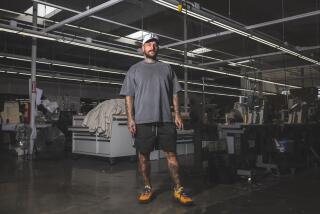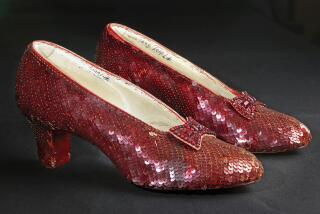A Mystery Shoe Leads to a Sole-Searching Experience
- Share via
Remember that shoe you lost? On Hobart, about three houses up from 2nd Street?
Well, you’re not going to believe this, but somebody has found it. Not only that, he’s willing, even eager, to return it.
No questions. No reward. All Marco Thorne asks is that you produce the shoe’s mate. Just so he’s sure that it’s yours, you understand. You can’t be too careful these days.
Thorne is not a petty man. Rather generous, actually. He just wants to be absolutely certain that the shoe falls into the proper hands--or feet, as the case may be.
Helpful Hints
He even supplies some clues to help you stake your claim. The owner of the shoe, he figures, is British or of British descent, likely from the Lake District. He or she is about 64 years old, possibly with a slight limp on the left side.
The shoe, by the way, was found in 1923.
In truth, it is a lovely little shoe, almost otherworldly. “A Pilgrim shoe!” thought Thorne, who was 9 years old when he found it.
Thorne and his classmates had been studying Colonial history at the grammar school on 2nd and Hobart--a school that still stands--and the lad had a lively imagination.
“I was living at 437 N. Harvard Blvd.,” he recalled last week. “My usual way to school was to bicycle down Harvard, across Beverly Boulevard--it was only 2 years old then, just a dirt road--to 1st Street. Right on 1st, then left on Hobart.
“On this particular morning, I was riding merrily down Hobart when I saw the shoe, right in the middle of the road. I jumped off my bike, all excited, and picked it up. It was heavier than I’d thought. Then I saw it had a solid wooden bottom.
“We’d been studying about the Plymouth Colony and the Puritans, and the shoe was unlike anything I’d ever seen. I took it in to my teacher--a Miss Mernin--and proudly announced, ‘Look! I’ve got a Pilgrim’s shoe!’
“ ‘Nonsense,’ said Miss Mernin. ‘Where did you get it, Marco?’
“I said I’d found it on the street in front of the Shillinglaws’ house. She told me to take it to Mrs. Henderson’s office--the principal--and see if she couldn’t find the owner.
“Miss Henderson was unimpressed too. She told me to take the shoe home, which was fine with me. I’d shown it to the other kids. Nobody was wildly excited; nobody claimed it. So I figured I’d done my part.
“Besides, I confess I’d become pretty attached to the little shoe.
“It was unusual; it was pretty. Above all, it was a mystery.”
The shoe sits today in the Thornes’ living room in San Diego, like something from a fairy tale, a Grimm reminder of a past populated by little people. It does that to you, the shoe; evokes a time when Ozma and Eeyore were a lot more real than Herbert Hoover or the Wobblies; when trolls lived under bridges and leprechauns danced on the green.
For a telltale instant, Thorne considered the leprechaun theory, then discarded it, coming down with a thud on the side of reality. “It’s a child’s shoe,” he said firmly, decisively. “A small child, perhaps 2 years old.”
Sturdy and Hand-Carved
True enough, if the shoe was ever worn by an elf, it was a blue-collar brownie. The sturdy, hand-carved wooden bottom, only 4 1/2 inches long, is reinforced by an iron plate, nailed on like a miniature horse shoe. High leather sides are attached to the sole by hand-hammered brass studs, while a black lacquered clasp secures the shoe over the tongue. The parts of the shoe that one would handle while putting it on--sides and tongue--are slightly scuffed. The shoe--a left one--definitely has been worn.
“By whom I don’t know,” said Thorne. “I’ve thought about it often. I’ve speculated that it might be a family keepsake that someone had
brought to school to show off--and lost, and got a good whipping. Then again, nobody at school had said he’d lost it. . . .”
Since it’s a working-class shoe, might it not have been worn by the child of a domestic, a strapping Scot or Welsh girl just off the boat and earning her keep?
“Possibly,” said Thorne. “It was a pretty middle-class neighborhood, but there were a few families who could afford help. . . .”
So the splendid if hypothetical colleen, on her half-day off, might have been taking her toddler for a walk down Hobart. The child would have complained that her foot hurt. . . .
“Why would she do that?”
Because of the nail just barely sticking up through the sole.
“What nail?”
Thorne pushed a finger into the shoe and shook his head. “Sixty-two years I’ve had the shoe and I’ve never noticed. But I see. The mother takes the shoe off, rubs the sore spot, forgets the shoe. . . .”
On the other hand, would it be likely that the child would hobble down the street Deedle-Dumpling-style, one shoe off and one shoe on . . . ?
The possibilities dwindle, but are not yet exhausted. There is the doll theory, for example. Even the dwende postulation. . . .
As a schoolboy, Thorne kept the shoe in a sack in his room, “but I often took it out, just to look at it. Once I took it to the Wilshire Branch Library. They fetched a few books, but in the end they couldn’t trace the shoe.
“From time to time I pursued it, but sort of lackadaisically. If you really want to know, I wasn’t all that anxious to part with the shoe.
“People, well, they just hold onto things. A lot of men I know still have their teddy bears. I still have a mustache cup I bought for a dime, thinking it was a large teacup. Did you ever try to drink tea out of a mustache cup?”
Thorne left home to go to Stanford; joined the Army; married and ended up in Dayton, where in 1943 his mother forwarded a package of miscellany--the detritus of a young man’s room, including mustache cup and, of course, the mysterious shoe.
‘Studs and All’
In time, Thorne, shoe still in tow, became city librarian of San Diego, where “I used to see a copy of every new book we bought.
“One day I came across a volume called ‘Empress Brown,’ about Queen Victoria carrying on with John Brown, her Scots groom, at Balmoral Castle. In the book was an 1867 cartoon of Brown taming the British Lion. I zeroed in on his shoes, very much like the one I have, studs and all.
“Several years later, one of our staff members had an exhibit of the clothes she’d worn as a child in Rochdale, England--and there were ‘my’ shoes! Hers were slightly larger. She was 3 at the time.”
There was a picture, too, in “The History of Shoe Fashions,” with the clog described as “worn in the mills” and “by quite young children.”
“I know, I know,” Thorne said. “People are going to say, ‘Here’s this guy with a BA from Stanford and masters in history and in librarianship. Why didn’t he look it up before now?’
“That’s a good question. There’s only one good answer: I was lazy.
“But I liked the shoe, the idea of carrying around a little mystery with me.
“Finally I found out, just last year, exactly what the shoe was. And you know, I think a little part of me died.”
Determining, somewhat sentimentally, that the shoe might better live out its remaining days with its own kind, Thorne contacted June Swann, Keeper of the Shoe Collection at Birmingham (England) Museum, only to learn that Birmingham “had ‘em by the dozen.”
Swann confirmed, though, that the shoe was “a type of clog worn in our North Country, the Lake District, Lancashire, Yorkshire,” sometimes “in industrial areas of Scotland, South Wales and the Midlands, though in the latter there was a certain stigma attached to them. . . .” (Thus the fate of wooden-shoe wearers through the ages. The refrain of a song still sung in Lorraine, France, goes: “And they laughed and called me ugly in my wooden shoes . ...” )
The clog, it seemed, was worn in the late 19th and early 20th centuries, “though the style lingered on well into the 1930s.”
Swann suggested that the Los Angeles County Museum of Art might be interested. Thorne dithered.
“I’d rather return it to the owner, if I could find him,” he said.
It remained but to explore the two remaining possibilities.
Could the shoe have been made for a doll?
“It occurred to me,” said Thorne. “It was hard to conceive that a human child could stand up in the thing, let alone walk in it. Then I realized the shoe was too thick, too substantial for a doll. And why would a doll need an adjustable buckle?
“No, that’s a shoe for a child who’s just walking. It would help a child to be steady on his or her pins.”
As for the dwende postulation:
Thorne’s visitor, back in Los Angeles, revisited the old neighborhood to retrace young Marco’s fateful bike ride.
Little changed since 1923, the neighborhood appears to be a tidy Asian-American enclave now: Japanese, Koreans, Chinese, a sprinkling of Filipinos.
Thorne’s old two-story house on Harvard still stands--clean, neat, now occupied by two families--as does the old Shillinglaw place on Hobart, the house in front of which the shoe was dropped.
The Chicos, a Filipino family, now live in the latter house. The visitor was warmly welcomed. Before an ad-hoc audience of five or six of the prettiest women he’d ever seen, the visitor told Thorne’s tale.
The story was received with giggling incredulity, then with interest, finally with a measure of wonderment.
“We moved here in 1973,” said matriarch Angelita Chico, busy sewing an exquisite white-and-gold gown for the forthcoming Filipino Festival in MacArthur Park. “But there were Filipino families in the neighborhood even before the ‘20s.
“And we do wear wooden shoes in the old country. We call them bakya .”
“But the bakya aren’t that tiny ,” protested Evelyn Chico Mendoza, Angelita’s married daughter. “I don’t think they make clogs that small in the Philippines
“Except, maybe, for the dwende .”
There was laughter in the room, and not a little eye-rolling.
“The dwende ,” Mendoza explained to the visitor, “are the ‘little people,’ the leprechauns of the Philippines. Sure, they could have been here in 1923.
“And I’ll bet, I’ll just bet, that if you find the other shoe, you’ll find a pot of gold too!”
Reached by telephone in San Diego, Thorne was delighted that his old house still stood but less sanguine over the prospect of a visit by the dwende .
“I really am anxious to return the shoe to the owner--the human owner,” he said. “All I ask is that the claimant show me the mate.”
“I’ll tell you what,” he added, reconsidering: “If someone can give me a plausible story-- really plausible--I’ll give it serious thought.
“But I would love to see the other shoe.”
One suspects, moreover, that he wouldn’t turn up his nose at a nice pot of gold.
More to Read
Sign up for The Wild
We’ll help you find the best places to hike, bike and run, as well as the perfect silent spots for meditation and yoga.
You may occasionally receive promotional content from the Los Angeles Times.






